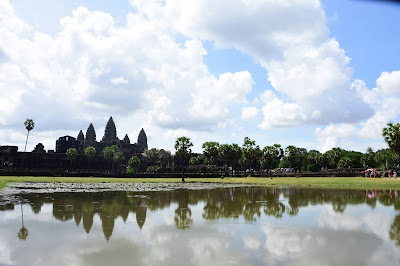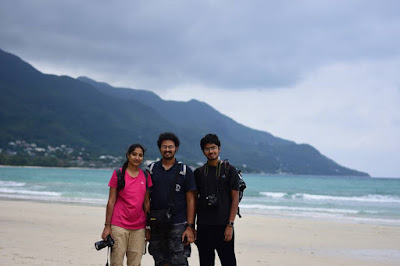 |
| Angkor Wat with monsoon clouds in the sky. |
If there's one thing that Cambodia is famous for, it's the Angkor Wat. The ancient temple features in everything from Cambodia's tourism sites to the Cambodian flag, military insignia and their currency. What is not that popular is the city of Angkor. The Angkor Wat is but a temple in the age old city of Angkor. The other ruins of the city as just as spectacular, if not more spectacular. The city has been the capital of the Khmer civilization and was originally Hindu, with the Angkor Wat being a Vishnu temple. About 800 years ago, Buddhism became popular in the area and Angkor Wat became a Buddhist temple. Unlike most cities of antiquity, Angkor was not built on the banks of a river or a lake or by the coast. It relied solely on the periodical phenomenon of the monsoon for its sustenance. Angkor was abandoned virtually overnight following the failure of the monsoon for a few consecutive years. Since then, nature took over, creating the wonder that it is today. The world comes together today to preserve these ruins. In fact, the Archaeological Survey of India sponsors and oversees the preservation of the Ta Phrom temple (a.k.a. Tomb Raider temple, after the movie) in Angkor. The people of Angkor had trade and cultural ties to India, whose religion they also imported. They also had contact with the Siamese of the east and the Chams and Vietnamese to the west. In fact, Bangkok has temples built in the Khmer style to this day, the famous Wat Arun (temple of the dawn) being one of them.
 |
| Some of the vegetarian food that one gets to eat. Fried tomato curry with steamed rice. |
Cambodia was always high on our bucket list as it was relatively easily accessible, backpacker-friendly, pocket-friendly and high on history. In fact, this was my second foreign history-oriented trip. Incidentally, the first one was to Istanbul, a Christian city which later became the capital of the Ottoman empire. One can draw several parallels between Istanbul and Angkor. The route to Angkor goes through Siem Reap, also known as the gateway to Angkor. The ruins all lie within a place called the Angkor Archeological Park. The entry is free to Cambodians and a hefty USD 62 for a 3 day pass to foreigners. We booked Air Asia, originating from Hyderabad and reaching Siem Reap via Kuala Lumpur (KLIA2). We timed the trip to coincide with Cambodian monsoon as that would mean a lesser tourist crowd and I wanted to see the force of nature which kept the city alive for centuries.
 |
| Our hosts, Ali and Samantha with their kid, Jasmine and dog, Lily. |
 |
| The Khmer Lion. Angkor Wat. |
We took off from Hyderabad's RGIA at the midnight of 6th July and reached Siem Reap by around 3:30PM on 7th July. Siem Reap Intl. Airport is a pretty small, reminding us of the likes of Antananarivo. It's one of the two international airports in Cambodia, the other being in the capital city of Phnom Penh. Sey Pov came to receive us on his tuk-tuk. He took us promptly to our homestay. We found wonderful hosts in Ali and Samantha at Fehi Dhuniye. Ali was Maldivian and Samantha Italian. Fehi Dhuniye translates into 'Green World' in Maldivian and is just that. It was raining cats and dogs by the time we reached. We waited for the rain to subside and headed out to buy the Angkor tickets. Pov told us that we are entitled to a free sunset at Angkor if we took the pass for the next 3 days. We bought the pass and went onwards to catch the sunset over Angkor Wat. We missed catching the brilliant colours in the sky as the monsoon put a load of cumulonimbus clouds all over the sky.
 |
| Angkor Wat from behind. |
 |
| A face from the temple of Bayon. |
 |
| Buddhist monk. Angkor Wat. |
 |
| Angkor Wat at sunrise. |
 |
| Srivani at Angkor Wat. |
The second day in Siem Reap started really early. We were up by 4:30AM and ready in an hour. Pov dropped us at Angkor Wat. We were able to get better shots of the sunrise as the monsoon clouds tend to clear up in the morning. We spend the next half of the day at Angkor Wat. Angkor Wat was built by Khmer ruler Suryavarman II a thousand years ago. The tall central spire is a characteristic of Khmer architecture and is seen in many Khmer temples. The five spires depict the five peaks of Mount Meru in Hindu mythology. The temple is adorned with carvings from Hindu mythology and those of the Khmer royals. We found several portraits of Suryavarman II himself in stone. After walking through the outer compound, we made it inwards. A limited number of tourists are allowed onto the central sanctuary, called the bakan, per day. We made it there and climbed up to the central spire. A gigantic idol of Vishnu once stood there, only to be replaced by the Buddha later. The view was amazing from up there. The rest of the Angkor ruins on one side and the modern city of Siem Reap on the other. We climbed down and walked around the outer compound and exited from the front.
 |
| Ta Phrom. |
 |
| Khmer Mi-8 helicopter. |
 |
| Artillery from the war museum. |
 |
| Leire, sketching ruins. Ta Phrom. |
We decided to walk from there to the Bayon temple, which is about 4 Km away. Bayon is also known as the temple of the thousand faces as it's adorned with innumerable faces, both large and small. Each face has a personality of its own with its own individuality. The irregular shape of the Bayon temple is said to represent the Mount Mandara, which was said to be used in the churning of the ocean of milk to extract elixir. There are four causeways which lead into Angkor, one in each of the four directions. Each of them feature carvings of serpents being pulled by demons and the gods. The whole city was designed to represent the legend of Samudra Manthan. In fact, an entire side of Angkor Wat is dedicated to depictions of the legend. We visited Bayon temple and then caught a tuk-tuk to Angkor Wat for about 4 USD. From Angkor Wat we caught another tuk-tuk to the Siem Reap War Museum. This museum contains the weapons used during the time of Pol Pot and the the Khmer Rouge, during the period known as the Cambodian civil war. This ended our day's excursion. The museum was less than a kilometre from Fehi Dhuniye and we walked home after that.
 |
| The temple of the thousand faces. Bayon |
 |
| Victory Gate. Western gate to Angkor Thom. |
The next day we decided to rent Ali's scooter for going around. We wanted to visit ruins on the other end of Angkor and that meant a ride of about 13 Km. We did not rent a tuk-tuk as they were too expensive and we wanted our own sweet time at each place to absorb it in completely. Our first destination for the day was Ta Phrom. On the way to the temple we found a band of musicians playing folk music and selling their audio CDs. These were victims of the war and its innumerable landmines. Ta Phrom is also known as the Tomb Raider temple as parts of the movie were set there. The main attractions here are the giant ficus trees rooting their way into the monument. We found out that the Indian ASI helps in maintaining the temple. Ta Phrom was built by the ruler, Jayavarman VII and named Rajavihara in honour of his family. It was later renamed to Ta Phrom. We then went on to the neighbouring Bantey Kdei, which is just right across the road from Ta Phrom. This temple has a similar setting as Ta Phrom and was built by the same king. It has a dried up moat around it. After visiting the nearby reservoir of Srah Srang, we went into Angkor Thom via the western gate (a.k.a. the Victory Gate). We had walked in from the southern gate the day before on the way to Bayon. We visited a few ruins near Bayon such as the terrace of the elephants and Baphuon. The terrace of the elephants has a few ruins scattered around it and we spent the better part of the day roaming that area. We had lunch in a roadside eatery nearby and rode back to Angkor Wat and then onwards to Fehi Dhuniye.
 |
| Churning of the sea of milk. Bas relief on Angkor Wat. |
 |
| Nagas on walls. |
 |
| The walk to Baphuon. |
 |
| Terrace of the elephants. |
 |
| Srivani in the outer gallery. |
The fourth day in Siem Reap took us to Angkor Wat for a second time. We wanted to spend more time going over the bas reliefs on the walls. The outer gallery in Angkor Wat is square in shape and thus has four walls. Each of these walls is divided in two and two bas reliefs are carved into them. Thus, there are a grand total of 8 bas reliefs around Angkor Wat, each depicting an aspect of Hindu mythology. One shows the churning of the sea of milk. One shows the Ramayana. One shows the cycle of life and death and yet another shows the true nature of karma and events from the puranas. We spent half the day going over these carvings and photographing Angkor Wat from various other perspectives. We then headed north into Angkor Thom via the southern gate and passing via Bayon, we exited via the northern gate. We proceeded onto the temple of Preah Khan. Preah Khan was built by Jayavarman VII as well and was very similar to the previous days's places. This is also largely taken over by nature. Right next to Preah Khan is Jayatataka barey, which is a large water body. The monsoon caught up with us by now and it began to pour. We walked into the temple in the middle of Jayatataka, called Neak Pean, to seek shelter. We sat in a tent along with some welcoming guards. While leaving, I gave one of them a picture of her baby taken with my Fuji Instax 8. Neak Pean was a hospital of sorts. It's divided into four quadrants, one each for every element. It was believed that a person falls sick due to an imbalance of the elements and bathing in the corresponding quadrant of Neak Pean would help rebalance them. We rode back after the rain to Bayon to take a few post-rain shots. The moat around Bayon had some water, giving us some good shots. We then rode back to the homestay.
 |
| Broken lion statue. Bantey Kdei. |
 |
| Angkor Thom from atop the terrace of the elephants. |
 |
| Sey Pov and his tuk-tuk. Siem Reap Intl. Airport. |
The next morning was our flight back to India. Pov dropped us at the airport in time and we were on our way. This trip was an awesome trip down history and this is one of the last few places in the world which can give such an experience.
 |
| Bantey Kdei. |


























Comments
Post a Comment